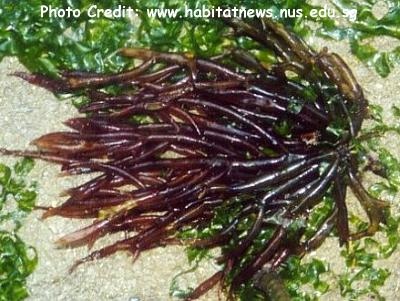
By Bob Goemans


Most aquarists realize it is difficult to find algae on the reef in the wild. Yet, there's always some calcareous and turf algae because they are actually important building components of any natural reef system. But with the reef's surrounding water nutrient poor and herbivores keeping what there is well mowed, little or none is readily visible. Nevertheless, it's another story in shallow inland waterways and bays where nutrients have a tendency to accumulate. There, algae in various forms and amounts can easily be seen and it's these types of algae that present the most problems for many aquarists.
And there are various colors of alga, e.g., green, brown, and red, and it can be single-cell, multicellular, encrusting, slime-like, or plant-like in appearance. Some perform beneficial functions such as the production of oxygen and removal of various toxic compounds, while others can be harmful to fishes and corals.
As for the 'Plant World' in general, most marine plants/algae in the wild are either too large or simply undesirable for aquarium use. Actually, the word 'plants' is a misnomer when discussing algae in general. Algae differ from terrestrial plants because they lack true leaves, root systems, and a system to transport nutrients. Since the term plants continues to be widely used in the aquarium industry, its use will somewhat continue here as appropriate.
My Species Library has four sections pertaining to algae/plants, Algae (Brown), Algae (Green), Algae (Red), and Vascular Plants/Seagrasses.
As for the first three, they are based on a color that loosely represents the type of algae or bacteria that fit into its category, i.e., Brown, Green, and Red. A forth is dedicated to Vascular Plants/Seagrasses. Each contains a species list with individual species also possibly having a 'Potential Control Species,' that identifies species that may consume it should it be an undesirable algae/plant species. Hopefully, you will find that additional aspect helpful in controlling unwanted growths in the aquarium.
As noted in the other sections/groupings in this website, there's room for additions and no doubt corrections. I've laid the groundwork, so please let's not criticize, simply pitch in and help! And since this is a visual gathering of this aspect of aquarium keeping, there's little or no related husbandry text explaining the conditions these species require or prefer. However, for that I highly recommend reading my Marine Algae Control Secrets booklet, Julian Sprung's Algae, A Problem Solving Guide, Vincent Hargreaves The Complete Book Of The Marine Aquarium, or Anthony Calfo & Bob Fenner Reef Invertebrates, An Essential Guide to Selection, Care and Compatibility. These books will greatly help you understand the conditions that bring about or sustain these growths and further ways to control or eradicate them.
The Division Rhodophyta is the largest group of tropical reef algae/plants consisting of over 5000 species. Some of these species contribute to reef building (such as coralline), some serve as a food source, few can add beauty to the aquarium, and some are troublesome. Whether they can be considered beneficial or unwanted depends upon the species being discussed below and how its cared for.
The pigmentation of these algae consists of beta-carotene, chlorophyll -a and c, and phycoerythrin. The cell walls are made up of cellulose and pectin compounds along with sometimes calcium carbonate and when so, they are called coralline algae.
As for the genera Gracilaria and Halymenia, they probably contain the prettiest of all red algae. They usually show up attached to live rock and can serve as decoration, a valuable foodstuff for herbivores or a way to export nutrients. They grow upright and usually form large masses of fronds. I've found some of those in these genera quite sensitive to slight changes in water chemistry. Just what those elements or compounds may be, I'm not sure but have seen perfectly good specimens quickly disintegrate overnight, even when there were no apparent changes to water quality. Therefore, trace element additions are advised if the goal is keeping any of these species, or in fact, any other 'red' forms of alga. Monitor calcium levels, as anything below 400 mg/l also seems to have a negative effect on them.
Also showing up in the trade sometimes is Botryocladia botryoides, a red bubble or grape algae that is quite stunning. Beautiful would be an understatement, but I found it also difficult to maintain long-term.
Finally, the red bubble algae Botryocladia skottsbergii is the most devastating form of bubble alga I've ever seen. Be sure to check it out below.
© 2012 Bob Goemans. All rights reserved.
The material on this site may not be reproduced, distributed, transmitted, cached or otherwise used, except with the prior written permission of Bob Goemans.

